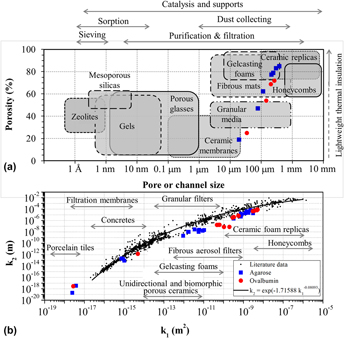Crossref Citations
This article has been cited by the following publications. This list is generated based on data provided by
Crossref.
Chen, Yugu
Huo, Wenlong
Zhang, Xiaoyan
Lu, Yuju
Yan, Shu
Liu, Jingjing
Gan, Ke
and
Yang, Jinlong
2019.
Ultrahigh‐strength alumina ceramic foams via gelation of foamed boehmite sol.
Journal of the American Ceramic Society,
Vol. 102,
Issue. 9,
p.
5503.
Khallok, Hamza
Ojala, Satu
Ezzahmouly, Manal
Elouahli, Abdelaziz
Gourri, El Hassan
Jamil, Mohamed
and
Hatim, Zineb
2019.
Porous foams based hydroxyapatite prepared by direct foaming method using egg white as a pore promoter.
Journal of the Australian Ceramic Society,
Vol. 55,
Issue. 2,
p.
611.
Stochero, N.P.
de Moraes, E.G.
Moreira, A.C.
Fernandes, C.P.
Innocentini, M.D.M.
and
Novaes de Oliveira, A.P.
2020.
Ceramic shell foams produced by direct foaming and gelcasting of proteins: Permeability and microstructural characterization by X-ray microtomography.
Journal of the European Ceramic Society,
Vol. 40,
Issue. 12,
p.
4224.
Guzi de Moraes, E.
Innocentini, M.D.M.
Biasetto, L.
Novaes de Oliveira, A.P.
Hotza, D.
and
Colombo, P.
2021.
Gel casting of silicon nitride foams using biopolymers as gelling agents.
Open Ceramics,
Vol. 8,
Issue. ,
p.
100183.
de Mello Innocentini, Murilo Daniel
Fuzatto Bueno, Bruno Ribeiro
Urbaś, Agnieszka
and
Morawska-Chochół, Anna
2024.
Microstructural, Fluid Dynamic, and Mechanical Characterization of Zinc Oxide and Magnesium Chloride-Modified Hydrogel Scaffolds.
ACS Biomaterials Science & Engineering,
Vol. 10,
Issue. 8,
p.
4791.
Shah, Muffarih
Hameed, Abdul
Kashif, Muhammad
Majeed, Noor
Muhammad, Javariya
Shah, Nasrullah
Rehan, Touseef
Khan, Abbas
Uddin, Jalal
Khan, Ajmal
and
Kashtoh, Hamdy
2024.
Advances in agar-based composites: A comprehensive review.
Carbohydrate Polymers,
Vol. 346,
Issue. ,
p.
122619.
Ali, Mohammed
Mohd Noor, Siti Noor Fazliah
Mohamad, Hasmaliza
Ullah, Faheem
Javed, Fatima
and
Abdul Hamid, Zuratul Ain
2024.
Advances in guided bone regeneration membranes: a comprehensive review of materials and techniques.
Biomedical Physics & Engineering Express,
Vol. 10,
Issue. 3,
p.
032003.
Romero, Arthur S.
Innocentini, Murilo D.M.
Vladimir Oliveira, J.
Lider, Andrey
Fey, Tobias
Travitzky, Nahum
and
Hotza, Dachamir
2025.
Unveiling the potential of silicon carbide as a support material and membranes for oily wastewater remediation.
Separation and Purification Technology,
Vol. 354,
Issue. ,
p.
129044.
